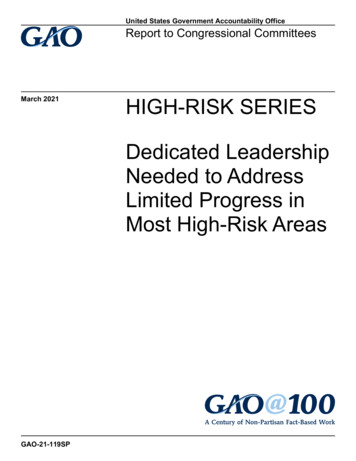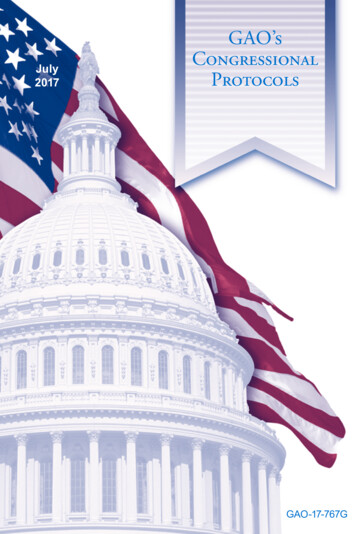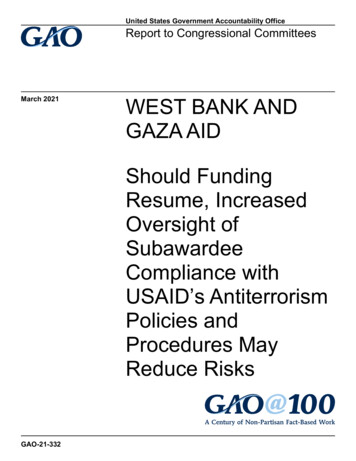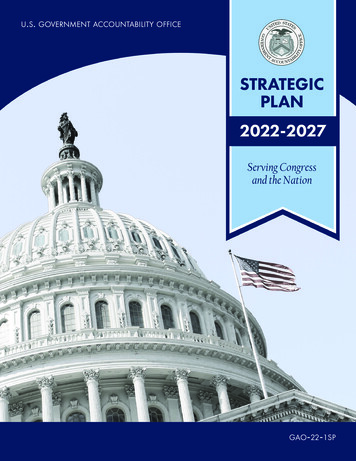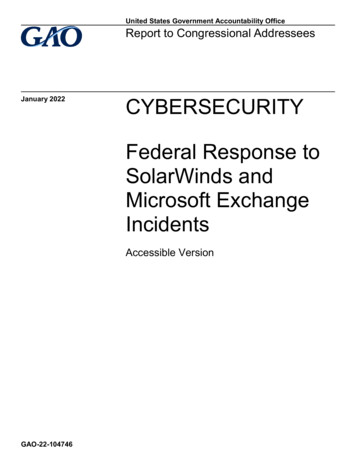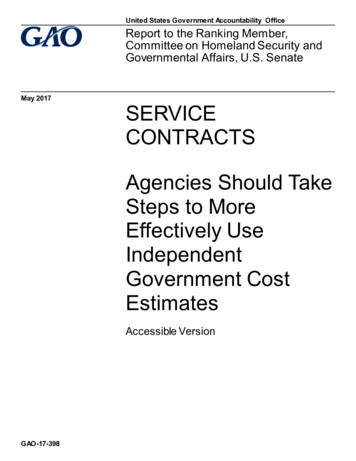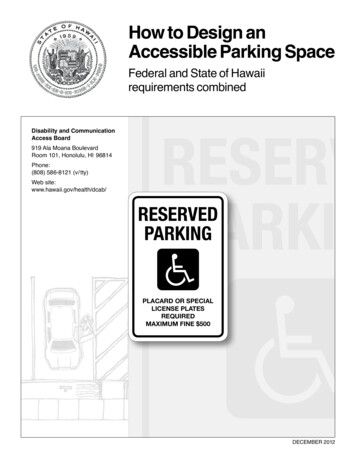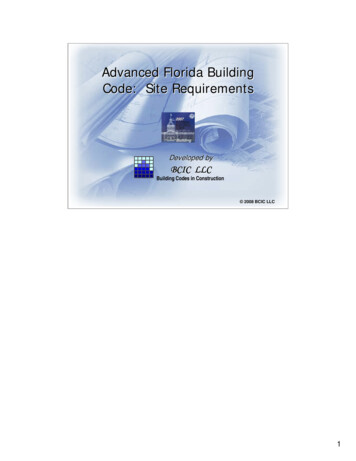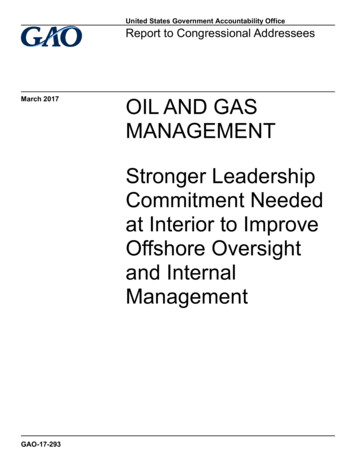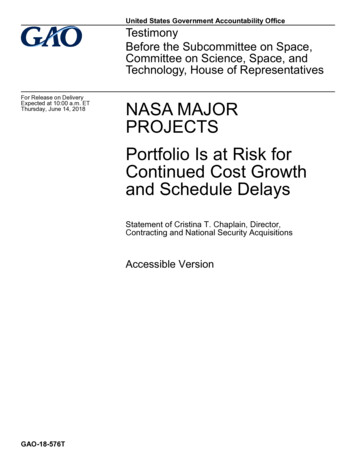
Transcription
United States Government Accountability OfficeTestimonyBefore the Subcommittee on Space,Committee on Science, Space, andTechnology, House of RepresentativesFor Release on DeliveryExpected at 10:00 a.m. ETThursday, June 14, 2018NASA MAJORPROJECTSPortfolio Is at Risk forContinued Cost Growthand Schedule DelaysStatement of Cristina T. Chaplain, Director,Contracting and National Security AcquisitionsAccessible VersionGAO-18-576T
June 14, 2018NASA MAJOR PROJECTSPortfolio Is at Risk for Continued Cost Growth andSchedule DelaysHighlights of GAO-18-576T, a testimonybefore the Subcommittee on Space,Committee on Science, Space, andTechnology, House of RepresentativesWhy GAO Did This StudyWhat GAO FoundGAO designated NASA’s acquisitionmanagement as a high-risk area in1990 after a history of persistent costgrowth and schedule slippage in manyof NASA’s major projects. In morerecent years, GAO found that NASAhad taken some steps to improve itsmanagement, and, in May 2017, GAOfound that projects were continuing agenerally positive trend of limiting costand schedule growth. But at the sametime, GAO noted that many of theseprojects, including some of the mostexpensive ones, were approaching thephase in their life cycles when cost andschedule growth is most likely.The cost and schedule performance of the National Aeronautics and SpaceAdministration’s (NASA) portfolio of major projects has deteriorated, but theextent of cost performance deterioration is unknown. NASA expects cost growthfor the Orion crew capsule—one of the largest projects in the portfolio—but doesnot have a current cost estimate. In addition, the average launch delay for theportfolio was 12 months, the highest delay GAO has reported in its 10 years ofassessing major NASA projects (see figure below).This statement summarizes GAO’s2018 findings from its 10th annualsnapshot of how well NASA is planningand executing its major acquisitionprojects, and describes (1) the costand schedule performance of NASA’sportfolio of major projects and (2) theextent to which NASA faces risks forfurther cost increases and scheduledelays. To conduct its review for the2018 report, GAO-18-280SP, GAOanalyzed cost, schedule, and otherdata for NASA’s 26 major projects,each with a life-cycle cost of over 250million; reviewed monthly project statusreports; and interviewed NASAofficials.What GAO RecommendsGAO is not making any newrecommendations in this statement.GAO has made recommendations inprior reports to strengthen NASA’sacquisition management of its majorprojects. NASA generally agreed withthese recommendations, but has notfully addressed some of them. GAOcontinues to believe they should befully addressed.View GAO-18-576T. For more information,contact Cristina Chaplain at (202) 512-4841 orchaplainc@gao.gov.NASA’s Major Project Portfolio Cost and Schedule Performance Deteriorated in 2018Data Table for Highlights figure, NASA’s Major Project Portfolio Cost and SchedulePerformance Deteriorated in 2018Fiscal YearPercentage cost growthAverage launch 8201437.87201525.97201617.38201715.67201818.812The deterioration in portfolio performance was the result of 9 of the 17 projects indevelopment experiencing cost or schedule growth.· Four projects encountered technical issues that were compounded by riskyprogram management decisions. For example, the Space Launch System andExploration Ground Systems programs are large-scale, technically complexhuman spaceflight programs, and NASA managed them to aggressiveschedules and with insufficient levels of cost and schedule reserves. Thismade it more difficult for the programs to operate within their committedbaseline cost and schedule estimates.United States Government Accountability Office
· Two projects ran into technical challenges that resulted in delays in theintegration and test phase. For example, in December 2017, GAO found thatthe James Webb Space Telescope project encountered delays primarily dueto the integration of the various spacecraft elements taking longer thanexpected, as well as the need to resolve technical issues during testing. GAOhas previously found that integration and testing is when projects are most atrisk of incurring cost and schedule growth.· Three projects experienced cost growth or schedule delays due to factorsoutside of the projects’ control, such as delays related to their launch vehicles.NASA continues to face increased risk of cost and schedule growth in futureyears due to new, large and complex projects that will enter the portfolio andexpensive projects remaining in the portfolio longer than expected.
LetterLetterChairman Babin, Ranking Member Bera, and Members of theSubcommittee:Thank you for inviting me to discuss the cost and schedule performanceof the National Aeronautics and Space Administration’s (NASA) portfolioof major acquisition projects. NASA’s major projects are the key enablersfor the agency to achieve its vision and its mission. They include NASA’sSpace Launch System (SLS) and Orion Multi-Purpose Crew Vehicle(Orion), which are the centerpieces of NASA’s human exploration plans;Mars 2020 and Europa Clipper, which will further our understanding of thehabitability of other planets; and the Ice, Cloud, and Land ElevationSatellite-2 (ICESat-2), which will provide better data on changes in theEarth. In its fiscal year 2019 budget request, NASA requested 19.9billion, which included about 4.5 billion for its deep space explorationprograms and research and about 6 billion for science programs andresearch. As these projects are complex and specialized, and often pushthe state of the art in space technology, NASA manages a portfolio thatwill always have inherent technical, design, and integration risks.We have been assessing the cost and schedule performance of NASA’smajor projects—those that have a life-cycle cost over 250 million—annually for 10 years. Over this time, we have seen NASA make progressin reducing acquisition risks, such as by improving cost and scheduleestimating tools, and establishing design metrics and tracking projectsagainst the metrics. But our most recent assessment in May 2018 foundthat the cost and schedule performance of the portfolio deteriorated afterseveral years of following a generally positive trend of limiting cost andschedule growth.1My statement today is based primarily upon our May 2018 report.Specifically, I will discuss (1) the cost and schedule performance ofNASA’s portfolio of major projects and (2) the extent to which NASA facesrisks for continued cost increases and schedule delays. To conduct thiswork, we collected cost and schedule information from NASA’s majorprojects using a data collection instrument, analyzed projects’ monthlystatus reports, interviewed NASA project and headquarters officials, andreviewed project documentation. At the time of our review, there were 26major projects in total, but the information available depended on where a1GAO, NASA: Assessments of Major Projects, GAO-18-280SP (Washington, D.C.: May 1,2018).Page 1GAO-18-576T
Letterproject was in its life cycle.2 For the 17 projects that were in theimplementation phase, we compared current cost and schedule estimatesto their original cost and schedule baselines. We reviewed historical dataon cost and schedule performance for major projects from our priorreports and compared them to the performance of NASA’s currentportfolio of major projects. More detailed information on our objectives,scope, and methodology for that work can be found in our May 2018report. In addition, we requested and received an update from NASA inearly June 2018 on whether the agency had completed a new life-cyclecost estimate for the Orion program. We also updated the actual launchdate for the Gravity Recovery and Climate Experiment Follow-On(GRACE-FO) project and updated information on the launch date for theIonospheric Connection Explorer (ICON) project.We conducted the work on which this statement is based in accordancewith generally accepted government auditing standards. Those standardsrequire that we plan and perform the audit to obtain sufficient, appropriateevidence to provide a reasonable basis for our findings and conclusionsbased on our audit objectives. We believe that the evidence obtainedprovides a reasonable basis for our findings and conclusions based onour audit objectives.BackgroundNASA Acquisition Life Cycle for Space Flight ProjectsThe life cycle for NASA space flight projects consists of two phases—formulation, which takes a project from concept to preliminary design, andimplementation, which includes building, launching, and operating thesystem, among other activities. NASA further divides formulation andimplementation into phases, phase A through phase F. Major projectsmust get approval from senior NASA officials at key decision pointsbefore they can enter each new phase. Formulation culminates in areview at key decision point C, known as project confirmation, where cost2Eight projects were in an early stage of development, called formulation, when there arestill unknowns about requirements, technology, and design. For those projects, wereported preliminary cost ranges and schedule estimates. The Commercial Crew Programhas a tailored project life cycle and project management requirements. As a result, it wasexcluded from our cost and schedule performance analysis.Page 2GAO-18-576T
Letterand schedule baselines are established and documented in a decisionmemorandum. Figure 1 depicts NASA’s life cycle for space flight projects.Figure 1: NASA’s Life Cycle for Space Flight ProjectsData for NASA’s Life Cycle for Space Flight ProjectsFormulationKDP ADecisionPointKDP B DecisionPointImplementationKDP C DecisionPoint(confirmationreview)Project startKDP DDecisionPointKDP EDecisionPointKDP F Decision NonePointPhasePre-phase A Phase AConceptConcept andstudiestechnologydevelopmentPhase BPreliminary designand technologycompletionPhase CPhase DPhase EFinal designSystemOperations andand fabrication assembly,sustainmentintegration andtest,and launchPhase FCloseoutReviewphaseNonePDR and CDRNoneNoneSDR/MDRSIRNoneNotes:Management decision reviewsKDP key decision pointTechnical reviewsPage 3GAO-18-576T
LetterSDR/MDR system definition review/mission definition reviewPDR preliminary design reviewCDR critical design reviewSIR system integration reviewAt the time of our review in May 2018, NASA had a portfolio of 26 majorprojects (see table 1). See appendix I for a brief description of eachproject.Table 1: Major NASA Projects Reviewed in GAO’s 2018 Assessment by PhaseProjects in formulationDouble Asteroid Redirection Test (DART)Europa ClipperLow Boom Flight Demonstrator (LBFD)LucyPlankton, Aerosol, Cloud, ocean Ecosystem (PACE)PsycheRestore-LWide-Field Infrared Survey Telescope (WFIRST)Projects inimplementationCommercial Crew Program (CCP)Exploration Ground Systems (EGS)Gravity Recovery and Climate Experiment Follow-On(GRACE-FO)Ice, Cloud, and Land Elevation Satellite-2 (ICESat-2)Interior Exploration using Seismic Investigations, Geodesy,and Heat Transport (InSight)Ionospheric Connection Explorer (ICON)James Webb Space Telescope (JWST)Landsat 9 (L9)Laser Communications Relay Demonstration (LCRD)Mars 2020NASA ISRO Synthetic Aperture Radar (NISAR)Orion Multi-Purpose Crew Vehicle (Orion)Parker Solar Probe (PSP) (formerly Solar Probe Plus)Radiation Budget Instrument (RBI)Space Launch System (SLS)Space Network Ground Segment Sustainment (SGSS)Surface Water and Ocean Topography (SWOT)Transiting Exoplanet Survey Satellite (TESS)Source: GAO analysis of National Aeronautics and Space Administration (NASA) data. GAO-18-576TPage 4GAO-18-576T
LetterNASA Acquisition Management as a High-Risk AreaNASA acquisition management is an area that we monitor on our highrisk list.3 Our high-risk series is a biennial report that keeps focusedattention on government operations with greater vulnerabilities to fraud,waste, abuse, and mismanagement or that are in need of transformationto address economy, efficiency, or effectiveness challenges. In 1990, wefirst designated the area as high risk because there was little emphasison end results, product performance, and cost control; the acquisitionprocess itself was cumbersome and time-consuming; and NASA founditself procuring expensive hardware that did not work properly. Forexample, in April 1990, NASA deployed the 1.5 billion Hubble SpaceTelescope and soon after, the agency discovered that the primary mirrorhad been manufactured in the wrong shape, severely degrading some ofthe telescope’s scientific capabilities.Subsequently, we and other organizations, including the NationalAcademy of Sciences and NASA’s Office of the Inspector General, foundthat NASA’s cost estimates were overly optimistic.4 Our reviews alsofound that NASA continued to experience significant cost and schedulegrowth due, in part, to not having a disciplined cost estimating process.·In 1992, we reviewed the cost and schedule performance of 29 NASAprograms and found that 25 of those programs experienced costgrowth that ranged from 14 to 426 percent above their initialestimates.5 Further, the median estimate change for all programs wasan increase of 77 percent. General reasons that NASA provided for3GAO, High-Risk Series: Progress on Many High-Risk Areas, While Substantial EffortsNeeded on Others, GAO-17-317 (Washington, D.C.: Feb. 15, 2017). We first designatedNASA contract management as a high-risk area in 1990. In 2009, we updated the title ofthe area to NASA acquisition management because of the scope of issues that needed tobe resolved to address persistent cost growth and schedule delays.4GAO, Space Programs: NASA’s Independent Cost Estimating Capability NeedsImprovement, GAO/NSIAD-93-73 (Washington, D.C.: Nov. 5, 1992); NASA ProgramCosts: Space Missions Require Substantially more Funding Than Initially Estimated,GAO/NSIAD-93-97 (Washington, D.C.: Dec. 31, 1992); National Research Council of theNational Academies, Controlling Cost Growth of NASA Earth and Space Science Missions(Washington, D.C.: National Academies Press, 2010); and NASA Office of InspectorGeneral, Inspector General Assessment of NASA's Most Serious Management andPerformance Challenges, (Washington, D.C.: Feb. 4, 2002) and NASA's IndependentCost Estimating Capability, IG-00-045 (Washington, D.C.: Sept. 20, 2000).5GAO/NSIAD-93-97.Page 5GAO-18-576T
Letterthe cost growth included insufficient definition studies, program andfunding instability, overly optimistic assumptions by program officials,and unrealistic contractor estimates. The more specific reasons forthe cost growth we found included program redesigns, technicalcomplexities, budget constraints, and incomplete cost estimates.In 2004, we reviewed the cost and schedule performance of 27 NASAprograms and found that 17 of the programs experienced costgrowth.6 Cost growth for 10 of the 17 programs was over 25 percent.We found that considerable change in NASA’s program costestimates—both increases and decreases—indicated that NASAlacked a clear understanding of how much its programs cost and howlong they will take to achieve their objectives. Further, we found thatNASA’s basic cost-estimating processes—an important tool formanaging programs—lacked the discipline needed to ensure thatprogram estimates are reasonable.In more recent years we have found that NASA’s leadership was focusedon improving acquisition outcomes and had taken some steps to improveits management.··In 2006, NASA established a management review process to enableNASA’s senior management to more effectively monitor a project’sperformance, including cost, schedule, and cross-cutting technicaland nontechnical issues.·In 2009, NASA began requiring that NASA major programs andprojects develop a joint cost and schedule confidence level (JCL) priorto project confirmation in order to ensure that cost and scheduleestimates were realistic and projects thoroughly planned foranticipated risks. The JCL is a point-in-time estimate that, amongother things, includes all cost and schedule elements, incorporatesand quantifies known risks, assesses the impacts of cost andschedule to date, and addresses available annual resources. NASApolicy generally requires that projects be baselined and budgeted atthe 70 percent confidence level.·In 2012, the agency established metrics to more consistently measurea project’s design progress and, in 2014, we found that most majorprojects in the portfolio were tracking and reporting those metrics. Inaddition, experts with whom we met confirmed that NASA’s metricsare valid measures to assess design maturity in space systems.6GAO, NASA: Lack of Disciplined Cost-Estimating Processes Hinders Effective ProgramManagement, GAO-04-642 (Washington, D.C.: May 28, 2004).Page 6GAO-18-576T
LetterSince 2015, we have observed a positive trend of higher numbers ofprojects maturing technologies prior to preliminary design review.7Demonstrating that technologies will work as intended in a relevantenvironment serves as a fundamental element of a sound businesscase, and projects falling short of this standard often experiencesubsequent technical problems. Our best practices work has shownthat maturing technologies prior to preliminary design review canminimize risks for projects entering development, which lowers therisk of subsequent cost growth and schedule delays.We believe that many of these steps NASA has taken contributed to thelargely positive trend of cost and schedule performance for NASA’sportfolio of major projects between 2013 and 2017. In our May 2017assessment of major projects, we found that out of 16 projects indevelopment, 5 experienced cost growth and 4 experienced scheduledelays over their development cost and schedule baselines.8 Both ofthese measures were at or near the lowest levels we have reported sincewe began our annual assessments in 2009.·However, we also found in our February 2017 high risk update that NASAneeded to do more with respect to anticipating and mitigating risks—especially with regard to large programs, estimating and forecasting costsfor its largest projects, and implementing management tools.9 Wehighlighted several actions that would be critical to improving NASA’sacquisition outcomes, including the following:·Ensuring that NASA conducted adequate and ongoing assessmentsof risks for larger programs because the impacts of any potentialmiscalculations will be felt across NASA’s portfolio.·Ensuring that NASA understood long-term human explorationprogram costs. While the three major human exploration programs—Orion, SLS, and the Exploration Ground Systems (EGS)—have beenbaselined, none of the three programs has a baseline that coversactivities beyond the second planned flight. Long-term estimates,which could be revised as potential mission paths are narrowed and7A technology is considered mature when it reaches a technology readiness level 6, whichis achieved after demonstrating a representative prototype of the technology in a relevantenvironment that simulates the harsh conditions of space.8GAO, NASA: Assessments of Major Projects, GAO-17-303SP (Washington, D.C.: May16, 2017).9GAO-17-317.Page 7GAO-18-576T
Letterselected, would provide decision makers with a more informedunderstanding of costs and schedules associated with potentialagency development paths.Ensuring that program offices regularly and consistently updated theirJCL across the portfolio. As a project reaches the later stages ofdevelopment, especially integration and testing, its risk posture maychange. An updated project JCL would provide both project andagency management with data on relevant risks that can guide projectdecisions.·Ensuring that NASA continued its efforts to build capacity in areassuch as cost and schedule estimating and measuring contractorperformance.Further, in our 2016 and 2017 assessments of major projects, we foundthat while the cost and schedule performance of NASA’s portfolio wasimproving, a number of large, complex projects were in or would soon beentering the integration and test phase—the phase in development thatoften reveals unforeseen challenges that can lead to cost and schedulegrowth.10 In May 2017, projects in this phase included all three humanspaceflight programs and the James Webb Space Telescope (JWST).11Subsequently, we found that these programs experienced delays duringthis phase of development. For example, in December 2017, NASAannounced a 13- to 19-month delay for the first integrated mission ofOrion, SLS, and EGS. This mission is referred to as Exploration Mission 1(EM-1) and will not have crew. In addition, in December 2017, we foundthat the JWST project continued to make progress towards launch, butthe program was encountering technical challenges that required bothtime and money to fix and may lead to additional delays.12 Subsequently,the JWST project delayed its launch readiness date by at least 19 monthsfrom October 2018 to May 2020.·10GAO, NASA: Assessments of Major Projects, GAO-16-309SP (Washington, D.C.: Mar.30, 2016); and GAO-17-303SP.11GAO-17-303SP.12GAO, NASA: Preliminary Observations on the Management of Space Telescopes,GAO-18-277T (Washington, D.C.: Dec. 6, 2017).Page 8GAO-18-576T
LetterPortfolio Cost and Schedule Deteriorated butExtent of Cost Growth Is UnknownThe cost and schedule performance of NASA’s portfolio of major projectsdeteriorated between May 2017 and May 2018, but the extent of costgrowth is unknown. NASA lacks a current cost estimate for its Orion crewcapsule—one of the largest programs in the portfolio—but expects theprogram will exceed its cost baseline when NASA updates the program’slife-cycle cost estimate. Because the Orion program accounts for about22 percent of all development costs, even a small percentage of costgrowth for the Orion program could significantly affect portfolio costperformance. The known negative cost and schedule performance islargely driven by the cost and schedule growth of four projects—SLS,EGS, Space Network Ground Segment Sustainment (SGSS) and Mars2020—that experienced technical problems compounded byprogrammatic challenges. Together, these projects experienced 638million in cost growth and 59 months in aggregate schedule delays. Twoprojects—JWST and ICESat-2—experienced schedule delays due totechnical challenges identified during integration and test. Another 3projects—NASA Indian Space Research Organisation Synthetic ApertureRadar (NISAR), ICON, and GRACE-FO—experienced cost growth ordelays largely due to factors outside of the projects’ control, such aslaunch vehicle delays.Portfolio Average Launch Delays Increased, but NASALacks a Current Orion Program Cost Estimate toDetermine Extent of Cost GrowthThe average launch delay increased from 7 months in our May 2017report to 12 months in our May 2018 report—the highest schedule delaywe have reported to date.13 We were not able to determine the extent ofportfolio cost growth this year because NASA does not have a currentcost estimate for the Orion program—one of the largest programs in itsportfolio—and officials expect the cost to increase. As of June 2017, theOrion program’s development cost was about 6.6 billion; based on thatestimate, it accounts for 22 percent of the portfolio’s estimated 30.1billion of development costs. As a result, a small percentage of cost13GAO-17-303SP.Page 9GAO-18-576T
Lettergrowth for the Orion program could significantly affect cost performance.Even without including Orion cost growth, the overall development costgrowth for the portfolio of 17 development projects increased to 18.8percent, up from 15.6 percent in 2017 (see figure 2).14Figure 2: Development Cost Performance and Average Launch Delay for MajorNASA Projects from 2009 to 201814We have historically presented cost and schedule performance including and excludingthe James Webb Space Telescope (JWST) because, prior to 2015, it had a developmentcost baseline significantly larger than other projects and the magnitude of its cost growthmasked the performance of the remainder of the portfolio. Now that other projects in theportfolio, such as Orion and the Space Launch System, have large development costbaselines, we no longer present cost performance trends excluding JWST.Page 10GAO-18-576T
LetterData Table for Figure 2: Development Cost Performance and Average Launch Delayfor Major NASA Projects from 2009 to 2018Fiscal YearPercentage costgrowthAverage launchdelayNumber of projectsin 201715.6716201818.81217Note: The years given in the figure refer to the year we issued each of our annual assessments ofNASA major projects reports. Cost and schedule performance is compared across each reportperiod.Senior-level NASA officials told us they expect that the HumanExploration and Operations Mission Directorate and the Orion programwill complete an updated life-cycle cost estimate in June 2018. This wouldbe approximately 10 months after the program raised to senior-levelofficials’ attention that the program expects cost growth over its costbaseline during an August 2017 briefing concerning potential costincreases related to the launch delay for EM-1.15 In early June 2018,NASA officials said that they had not yet completed the updated life-cyclecost estimate.In our May 2018 report, we found that 7 of 17 NASA major projects hadstayed within cost and schedule estimates since our 2017 annualassessment of major projects, but 9 projects experienced cost growth orschedule delays and cost growth is expected for the Orion program.Table 2 provides data on the cost and schedule performance between ourMay 2017 and 2018 reports for the 17 major projects in development thathave cost and schedule baselines.1615The Orion program is baselined to the second combined mission of Orion, SLS, andEGS. This mission is known as Exploration Mission 2 (EM-2) and will have crew.16GAO-17-303SP.Page 11GAO-18-576T
LetterTable 2: Development Cost and Schedule Performance of Selected Major NASA Projects in Development as of May 2018AssessmentOverall performanceLower than expected costWithin baselineHigher than expected es betweenMay 2017 and May e(months)Cost(millions)Schedule(months)PSP2014 0.00- 5.40GRACE-FO2014- 1.63- 2.23TESS2014- 13.1-2- 39.9-2ICON2014 0.08 0.08SWOT2016 0.00 0.00LCRD2017 0.00 0.00Landsat 92017 0.00 0.00Mars 2020a2016 12.90 10.70NISAR2016 22.00 22.00InSight2014 0.00 131.726EGS (EM-1)2014 417.819 421.419SLS (EM-1)2014 147.819 147.819JWST2008 0.019 3,607.771ICESat-2SGSSbCanceledRBIUnder revisionOrion (EM-2)Total--d2012 1.44 206.3172013 59.521 421.6482016 0.00 0.002015 0.00- 151.70 646.791 4,770.0209--Legend: PSP: Parker Solar Probe; GRACE-FO: Gravity Recovery and Climate Experiment Follow-On; TESS: Transiting Exoplanet Survey Satellite;ICON: Ionospheric Connection Explorer; SWOT: Surface Water and Ocean Topography; NISAR: NASA Indian Space Research Organisation –Synthetic Aperture Radar; LCRD: Laser Communications Relay Demonstration; InSight: Interior Exploration using Seismic Investigations, Geodesy, andHeat Transport; EGS: Exploration Ground Systems; SLS: Space Launch System; EM-1: Exploration Mission 1; JWST: James Webb Space Telescope;ICESat-2: Ice, Cloud, and Land Elevation Satellite-2; SGSS: Space Network Ground Segment Sustainment; RBI: Radiation Budget Instrument; Orion:Orion Multi-Purpose Crew Vehicle; EM-2: Exploration Mission 2.Source: GAO analysis of National Aeronautics and Space Administration (NASA) data. GAO-18-576TNote: The confirmation date is the year NASA established and documented a cost and schedulebaseline for each project. Positive values indicate cost growth or launch delays. Negative valuesindicate cost decreases or earlier than planned launch dates.aThe Mars 2020 project used 2.2 million in funds originally budgeted for development for formulationactivities. This partially offsets an increase of 12.9 million in development cost growth primarily dueto increased costs associated with a technology demonstration instrument and entry, descent, andlanding instrument.bThe SGSS project reported cost growth up through its first operational readiness review, which iscurrently planned for the end of fiscal year 2019. However, the project expects that there could beadditional cost and schedule growth beyond what is reported here.cA replan process is initiated if development costs increase by 15 percent or more. NASA replannedthe SLS program even though development costs did not increase by 15 percent or more. A replandoes not require a new project baseline to be established. A rebaseline is a process initiated ifdevelopment costs increase by 30 percent or more. When development cost growth is likely toPage 12GAO-18-576T
Letterexceed the development cost estimate by 15 percent or more, NASA must submit a report to theCommittee on Science, Space, and Technology of the House of Representatives and the Committeeon Commerce, Science, and Transportation of the Senate. In addition, if a project or programmilestone is likely to be delayed by 6 months or more, this report is also required.dNASA officials said they are revising the Orion program’s life-cycle cost estimate and expect tocomplete a new estimate in June 2018. The new cost is expected to exceed the program’sdevelopment cost baseline. The current costs in the table reflect the estimate provided in June 2017.The cumulative cost change reflects the program shifting 151.7 million of funding previouslybudgeted for the development phase to the formulation phase.The deteriorating cost and schedule performance of the portfolio in 2018is the result of·four projects—SLS, EGS, SGSS, and Mars 2020—addressingtechnical challenges that were compounded by
The cost and schedule performance of the National Aeronautics and Space Administration's (NASA) portfolio of major projects has deteriorated, but the extent of cost performance deterioration is unknown. NASA expects cost growth for the Orion crew capsule—one of the largest projects in the portfolio—but does not have a current cost estimate.
